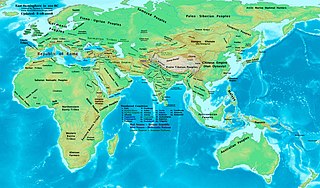Related Research Articles

The Arabs, also known as the Arab people, are an ethnic group mainly inhabiting the Arab world in West Asia and North Africa. A significant Arab diaspora is present in various parts of the world.

Religion in pre-Islamic Arabia included indigenous Arabian polytheism, ancient Semitic religions, Christianity, Judaism, Mandaeism, Hinduism and Zoroastrianism.

Mithraism, also known as the Mithraic mysteries or the Cult of Mithras, was a Roman mystery religion centered on the god Mithras. Although inspired by Iranian worship of the Zoroastrian divinity (yazata) Mithra, the Roman Mithras was linked to a new and distinctive imagery, and the level of continuity between Persian and Greco-Roman practice remains debatable. The mysteries were popular among the Imperial Roman army from the 1st to the 4th century CE.
Shia Islam is the second-largest branch of Islam. It holds that the Islamic prophet Muhammad designated Ali ibn Abi Talib as his successor and the Imam after him, most notably at the event of Ghadir Khumm, but was prevented from succeeding Muhammad as the leader of the Muslims as a result of the choice made by some of Muhammad's other companions at Saqifah. This view primarily contrasts with that of Sunni Islam, whose adherents believe that Muhammad did not appoint a successor before his death and consider Abu Bakr, who was appointed caliph by a group of Muhammad's other companions at Saqifah, to be the first rightful (rashidun) caliph after Muhammad.

Hadhramaut is a geographic region in southern Arabia, comprising mainly of the eastern Governorates of Yemen, the Dhofar Governorate in south-western Oman and the Najran Province in southern Saudi Arabia. The name is of ancient origin, and is retained in the name of the Yemeni Governorate of Hadhramaut. The people of Hadhramaut are called Hadharem. They formerly spoke Hadramautic, an old South Arabian language, but they now predominantly speak Hadhrami Arabic.

The Sabaeans or Sabeans were an ancient group of South Arabians. They spoke Sabaic, one of the Old South Arabian languages. They founded the kingdom of Sheba in modern-day Yemen, which was mentioned in the bible and the Quran and "the oldest and most important of the South Arabian kingdoms".

The Himyarite Kingdom was a polity in the southern highlands of Yemen, as well as the name of the region which it claimed. Until 110 BCE, it was integrated into the Qatabanian kingdom, afterwards being recognized as an independent kingdom. According to classical sources, their capital was the ancient city of Zafar, relatively near the modern-day city of Sana'a. Himyarite power eventually shifted to Sana'a as the population increased in the fifth century. After the establishment of their kingdom, it was ruled by kings from dhū-Raydān tribe. The kingdom was named Raydān.

The kingdom of Kuninda was an ancient central Himalayan kingdom documented from around the 2nd century BCE to the 3rd century CE, located in the southern areas of modern Himachal Pradesh and far western areas of Uttarakhand in northern India and Doti Gadwall in Nepal.

The Azd, or Al-Azd, is an ancient Arabian tribe. The lands of Azd occupied an area west of Bisha and Al Bahah in what is today Saudi Arabia.

Pre-Islamic Arabia, referring to the Arabian Peninsula before Muhammad's first revelation in 610 CE, is referred to in Islam in the context of jahiliyyah, highlighting the prevalence of paganism throughout the region at the time.

The Hashid is a tribal confederation in Yemen. It is the second or third largest – after Bakil and, depending on sources, Madh'hij – yet generally recognized as the strongest and most influential. According to medieval Yemeni genealogies, Hashid and Bakil were the sons of Jashim bin Jubran bin Nawf Bin Tuba'a bin Zayd bin Amr bin Hamdan. Member tribes of the Hashid Confederation are found primarily in the mountains in the North and Northwest of the country.

The ancient history ofYemen or South Arabia is especially important because it is one of the oldest centers of civilization in the Near East. Its relatively fertile land and adequate rainfall in a moister climate helped sustain a stable population, a feature recognized by the ancient Greek geographer Ptolemy, who described Yemen as Eudaimon Arabia meaning Fortunate Arabia or Happy Arabia. Between the eighth century BCE and the sixth century CE, it was dominated by six main states which rivaled each other, or were allied with each other and controlled the lucrative spice trade: Saba', Ma'īn, Qatabān, Hadhramaut, Kingdom of Awsan, and the Himyarite Kingdom. Islam arrived in 630 CE and Yemen became part of the Muslim realm.

Dalverzin Tepe is an ancient archaeological site founded by the Graeco-Bactrian Kingdom and located near to the modern city of Denau in the Surxondaryo Region of Uzbekistan. The city was founded in the 3rd century BC and rose to prominence in the Kushan period when two important Buddhist temples were built here. Dalverzin Tepe was excavated by the famed Soviet archeologist Galina Pugachenkova.
The Bakil federation is the largest tribal federation in Yemen. The tribe consists of more than 10 million men and women they are the sister tribe of Hashid(4 million) whose leader was Abdullah Bin Hussein Alahmar. The member tribes of the Bakil Confederation are found primarily in the far north of the country; its leaders today is the Alshaif family led by Nagi bin Abdulaziz Alshaif.

Qataban was an ancient South Semitic-speaking kingdom of South Arabia that existed from the early 1st millennium BCE to the late 1st or 2nd centuries CE.

Ẓafār, also Romanized Dhafar or Dhofar, is an ancient Himyarite site situated in Yemen, some 130 km south-south-east of today's capital, Sana'a, and c. 10 kilometres (6.2 mi) south-east of Yarim. Given mention in several ancient texts, there is little doubt about the pronunciation of the name. Despite the opinion of local patriots in Oman, this site in Yemen is far older than its namesake there. It lies in the Yemeni highlands at some 2800 m. Zafar was the capital of the Himyarites, which at its peak ruled most of the Arabian Peninsula. For 250 years the tribal confederacy and allies' combined territory extended past Riyadh to the north and the Euphrates to the north-east.

Biʾr ʿAlī is a village in eastern Yemen. It is located in the Shabwah Governorate. The name means "Ali's Well" in Arabic. In pre-Islamic times, the port was called Qanīʾ.

Ḥaḍramawt was an ancient South Semitic-speaking kingdom of South Arabia which existed from the early 1st millennium BCE till the late 3rd century CE in the area currently named after it in the region of the Ṣayhad desert.

The Barran Temple is a Sabaean temple near Marib, Yemen; also known as the "Throne of Bilqis", it dates back to the 10th century BCE and was dedicated to the god al-Maqah.
References
- ↑ Beeston, A. F. L; Mundy, C. S; Berry, J (1955). "Notes and Communications". Bulletin of the School of Oriental and African Studies, University of London. 17 (1): 154–165. doi:10.1017/s0041977x00106408. JSTOR 609235.
- ↑ Oğuzhan, İbrahim. "İstanbul Arkeoloji Müzeleri Eski Şark Eserleri Müzesinde Teşhir Edilen İslamiyet Öncesi Arabistan Koleksiyonu Eserlerinin Tahlili, 2.3.1. Yazıt 1 (Envanter no. 7502)". Archivum Anatolicum (in Turkish). 15/2, 2021: 489 – via DergiPark.
- ↑ St. John Simpson (2002). Queen of Sheba: treasures from ancient Yemen. British Museum Press. pp. 162, 163. ISBN 9780714111513.

